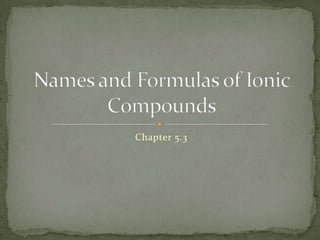
Applied Chapter 5.3 : Names and Formulas of Compounds
- 1. Chapter 5.3 Names and Formulas of Ionic Compounds
- 2. Objectives Name cations, anions, and ionic compounds Write chemical formulas for ionic compounds such that an overall neutral charge is maintained. Explain how polyatomic ions and their salts are named and how their formulas relate to their names.
- 3. Chemical names and Formulas Calcium carbonate – Sodium chloride – Dihydrogen monoxide – These are their chemical and common names Chemical names help to describe the atomic makeup of the compounds
- 4. Chemical formula for ionic compound Ionic compound consists of lattice of positive and negative ions held together by mutual attraction. Chemical formula represented by one unit cell Simplest ratio of the compounds positive and negative ions Aluminum sulfate below consists of aluminum cations and sulfate ions Al2(SO4)3 Subscript 3 refers to everything inside the parentheses giving 3 sulfate ions, with a total of 3 sulfur atoms and 12 oxygen atoms Subscript 2 refers to 2 Aluminum atoms Subscript 4 refers to 4 oxygen atoms in the sulfate ion Note: when you only have one of an atom, no subscript is used Note: parentheses are used to identify polyatomic ion as one unit
- 6. Examples
- 7. Carbon & Silicon form covalent bonds
- 8. d-block elements form variable charges
- 9. examples
- 10. Copper, can be Cu+1 or Cu+2
- 11. Iron, can be Fe+2 or Fe+3
- 13. Base of element + -ide ending
- 14. Ex: F-1 Fluoride N-3 Nitride O-2 _______ Br-1 _______
- 16. Name cation first : full name of cation
- 17. Aluminum
- 18. Name Anion last : base of anion + -ide
- 23. Do not use roman numerals ( main group elements)
- 24. No Anions form more than one charge+2 -1 CuCl2 copper(II) chloride
- 27. Anion with one less oxygen has –ite ending
- 28. Anion with two less oxygen has hypo prefix and –ite ending
- 29. Anion with one extra oxygen has per prefix and –ate endingClO3-1 ClO2-1 ClO-1 ClO4-1 hypochlorite perchlorate chlorate chlorite
- 30. Naming Compounds with Polyatomic Ions Same as naming for ionic compounds except Name polyatomic ion as one unit Example: AgNO3 Use parentheses if more than one polyatomic ion Example Al2(SO4)3 silver nitrate Show 2 Al+3 ions and 3 SO4-2 ions aluminum sulfate